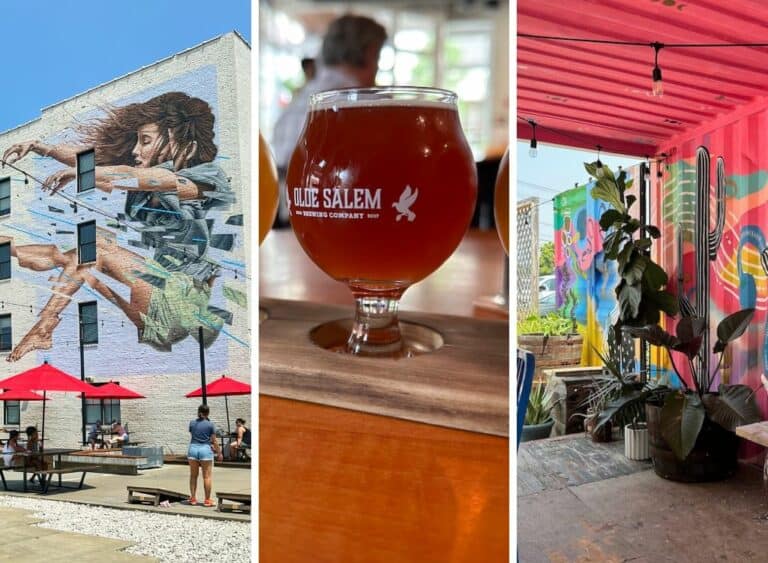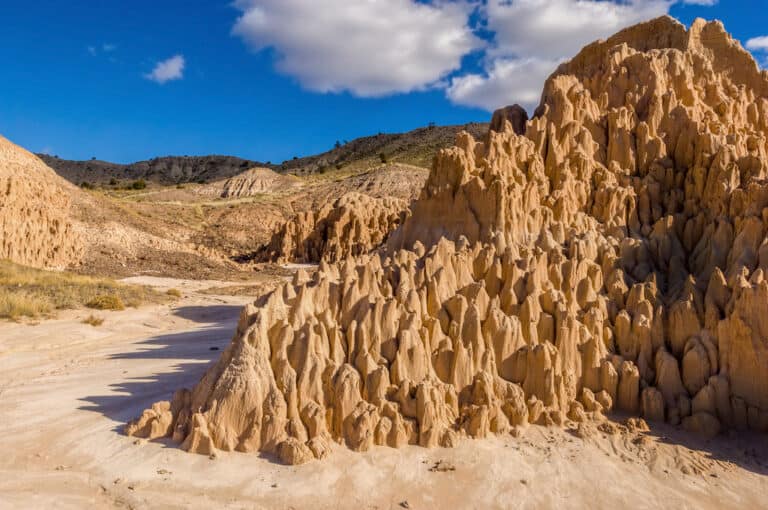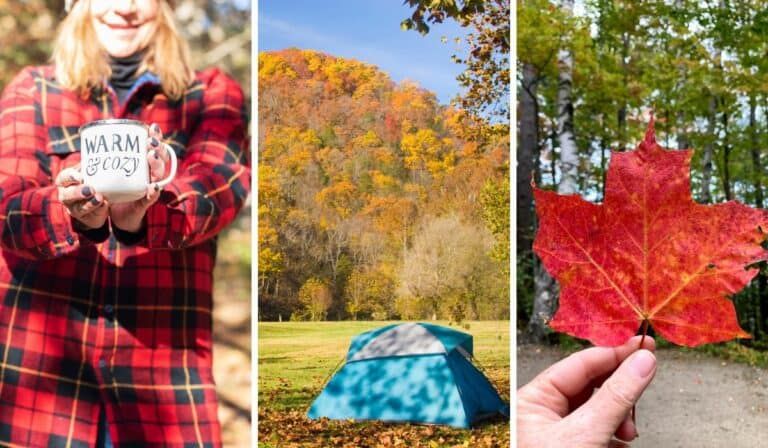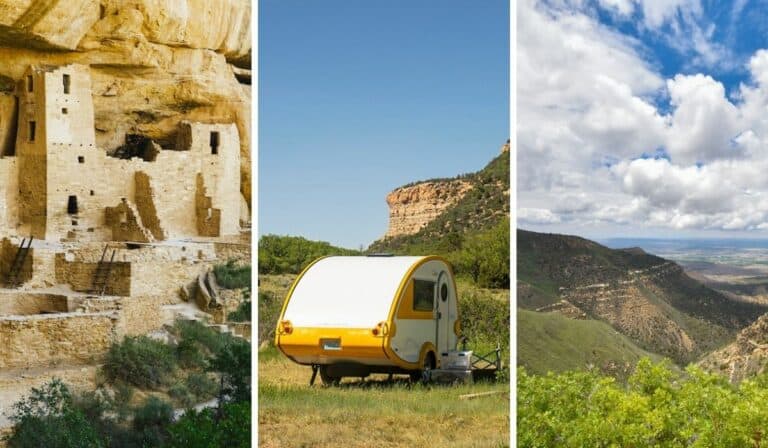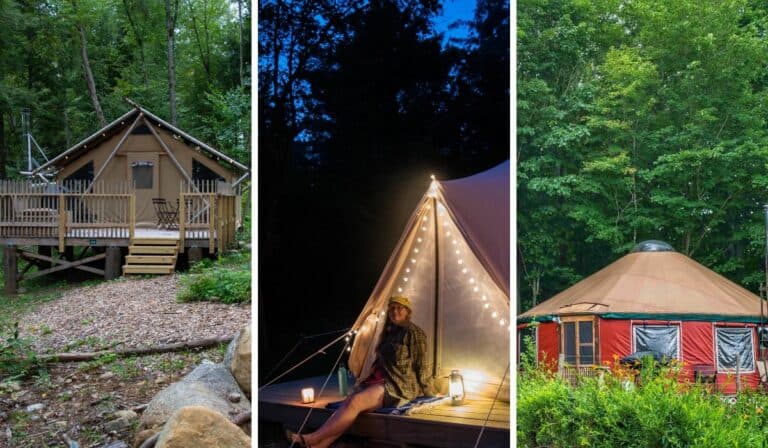Family Adventure Guide: Joshua Tree National Park
Note: Advertising is how we keep this site free for you to enjoy, and we earn a commission from affiliate links that may be included in this post. Thank you for supporting Back Road Ramblers!
America’s 63 national parks are breathtakingly beautiful and incredibly diverse, encompassing wild seashores, towering mountains, dark rainforests, and vast deserts.
One of the most unique is Joshua Tree National Park in Southern California.

Joshua Tree’s otherworldly landscape, easy hiking opportunities, and awesome campgrounds make it a perfect park to explore with kids.
Last winter, I had the honor of exploring Joshua Tree National Park and its harsh and varied ecosystem sprawling across 800,000 acres in Southern California.
I’m not lying when I say there are endless opportunities for exploring in Joshua Tree, and despite less-than-cooperative weather (snow!), we did a lot of adventuring!
I think it’s safe to say that Joshua Tree National Park is one of my favorite places in the world.
There’s magic in that desert, and I am already planning my next trip. In the meantime, I want to share some Joshua Tree National Park highlights, including the best hikes in Joshua Tree for families and an overview of Joshua Tree camping.
Table of Contents
Joshua Tree National Park At-A-Glance
Here’s a bite-sized snapshot of everything you need to know to plan your trip to Joshua Tree with kids.
- When to Go: October to April for pleasant temps.
- Where to Stay: Camp at Jumbo Rocks Campground
- How to get here: It’s about 3 hours from McCarran International Airport in Las Vegas (LAS) or 3.5 from Los Angeles (LAX).
- How to Get Around: To explore all of Joshua Tree National Park, you will need a car.
- Top 3 Highlights: Sunrise from Jumbo Rocks Campground, hike to Barker Dam, and the Keys Ranch Tour.
- Official Park Website
Camping in Joshua Tree National Park
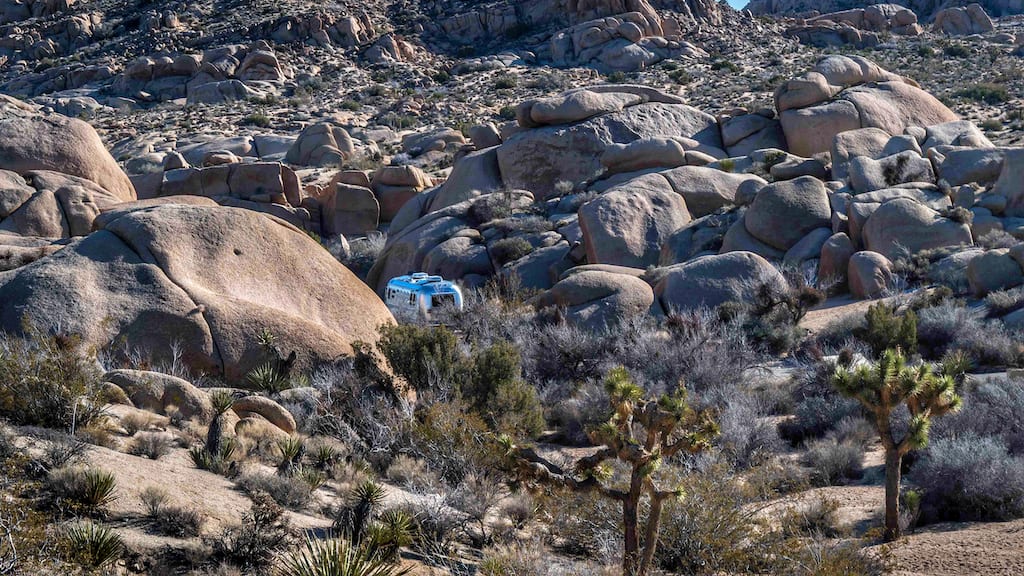
You don’t have to camp in Joshua Tree National Park to explore it properly, but I highly recommend trying it!
Sunrises and sunsets are magical in the park, and nighttime is one of the best times to explore, even if you’re just walking the campground road and admiring the stars.
I can’t speak for every single one of the nine developed campgrounds within Joshua Tree, but I can give you a few tips based on our experiences — we have visited most of the campgrounds looking for the perfect spot, and as long as you bring plenty of water (for drinking, washing, and cooking), my top recommendation would be Jumbo Rocks Campground.
In my humble opinion, Jumbo Rocks Campground provides the best of Joshua Tree camping, but here are all of your choices so you can pick what’s right for you:
- Black Rock Campground: Reservations required. Just five miles from shopping and restaurants in Yucca Valley. There are potable water and flush toilets at Black Rock, and 99 sites suitable for tents or RVs up to 35 feet in length. No hook-ups are provided, but there is good cell service.
- Cottonwood Campground: Reservations required. Located in the southeast corner of the park, Cottonwood has potable water and flush toilets. All 62 sites can be reserved ahead of time and are suitable for tents and RVs up to 35 feet. Because Cottonwood is lower in elevation than other campgrounds, it’s also warmer at night and a good choice for winter camping. No cell service and no hookups.
- Indian Cove Campground: Reservations required. 101 campsites for tents and RVs up to 35 feet. Indian Cove has vault toilets and no water. Spotty cell service and no hookups.
- Jumbo Rocks Campground: Reservations required. Jumbo Rocks is centrally located with amazing rock formations. 124 sites for tents and RVs up to 35 feet. Vault toilets and no water. No cell service and no hookups.
- Ryan Campground: Reservations required. 31 sites for tents and RVs up to 35 feet, but no hookups. adjacent to the California Riding and Hiking Trail. Vault toilets and no potable water or cell service.
- Belle Campground: First come, first served. Small 18-site campground with vault toilets, no water, and no cell service. A remote and quiet campground suitable for tent campers and RVs up to 35 feet, but no hookups are provided.
- Hidden Valley Campground: First come, first served. 44 sites with vault toilets, no water, and no cell service. This is also one of the busiest campgrounds in the park and seems to cater more to climbers who take advantage of the great climbing routes in Hidden Valley.
- White Tank Campground: First come, first served. Located in a remote northern section of the park, White Tank provides vault toilets but no water or cell service. RVs under 24 feet are permitted, but there are no hook-ups.
Insider tip: There is no firewood available in Joshua Tree National Park, so if you’ve got visions of campfires and s’mores dancing in your head, be sure to buy bundles of wood outside the park and bring it in.
Camping at Jumbo Rocks Campground in Joshua Tree National Park
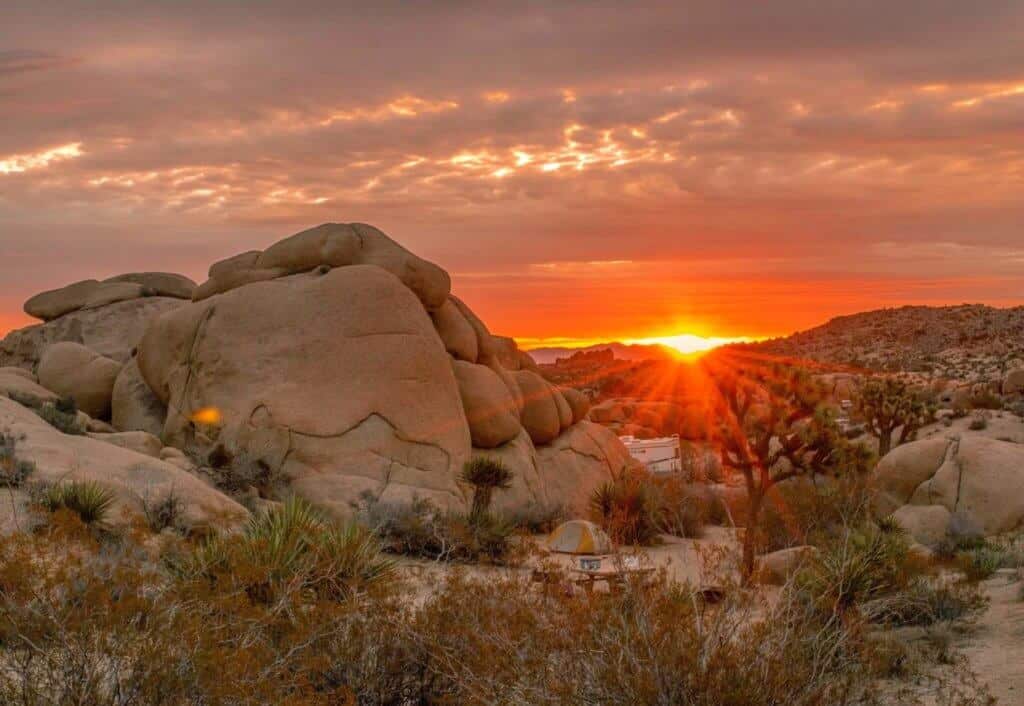
Jumbo Rocks Campground encompasses a surreal landscape in the heart of the park and has 124 campsites that provide ample space and privacy. Reservations are required and can be made online at Recreation.gov. Same-day reservations can be made if sites are available.
Most sites are spacious, nestled into the giant boulders and dotted with Joshua trees for privacy.
The endless fields of boulders provide an incredible backdrop for photos, and adventurous kids (and adults) will love exploring the campground.
Jumbo Rocks Campground is centrally located in the heart of the park, making it easy to plan all of your adventures from a central location.
The Skull Rock Nature trail begins and ends in Jumbo Rocks, and many of our favorite Joshua Tree hiking trails and adventures are just a short drive away.
The town of Joshua Tree (our favorite for eating out) is 23 miles away, and Twentynine Palms is just 13 miles away. We loved sites #14, 15, and 16 in Jumbo Rocks Campground, but most campsites are equally awesome.
There are a few reasons why you may want to choose another campground over Jumbo Rocks Campground. If the weather promises to be chilly through the night, you might want to pitch your tent in Cottonwood Springs, which is a good 10 degrees warmer than the more northern campgrounds.
If running water is a necessity, choose Cottonwood Springs or Black Rock Campground. There is no running water at Jumbo Rocks Campground. We filled up several jugs at the visitor center.
Insider tip: Is having good cell service while camping important to you? The only campground that has reliable cell service is Black Rock Campground near the town of Yucca Valley.
Don’t want to camp? Read: Best Glamping Near Joshua Tree
The Best Easy Hikes in Joshua Tree
Joshua Tree National Park has some of the most family-friendly hikes anywhere, provided you plan ahead and pack appropriately.
The following Joshua Tree hiking trails are easy and fun for all ages. They are all under two miles and without substantial elevation gains.
If you’re an experienced hiker with older kids, I highly recommend the Lost Horse Mine Loop, which I’m not including in this list.
All of these Joshua Tree hikes are located in the Mojave Desert section of the park, not far from Jumbo Rocks Campground.
Insider tip: We use AllTrails for discovering hikes and when we travel. The free version is awesome, but AllTrails+ ($35.99 a year) allows you to download maps for offline use, which we found very useful in Joshua Tree National Park.
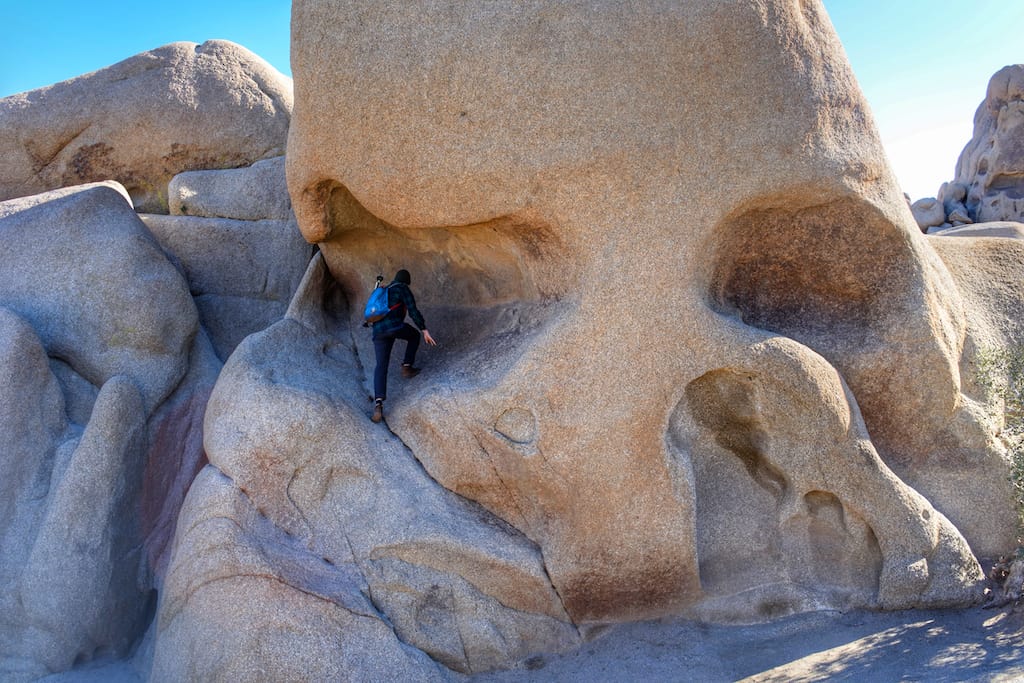
Skull Rock Nature Trail – 1.7-mile loop: This is a super easy and interesting hike that begins and ends at Jumbo Rocks Campground.
If you begin at the trailhead inside the campground and hike counter-clockwise, you will come to Skull Rock right away, cross the road, and then head through a large wash and meander among beautifully sculpted boulders.
Interpretive signs dot the landscape, and the kids will enjoy scrambling around on the rocks. The trail ends (or begins) right outside the campground entrance.
Live Oak Loop – .9 mile loop: This great little loop is full of cool rock spires and other formations, with lots of nooks for exploring. The trail gets its name from the giant (and rare) live oak tree nearby. Pack a picnic for this one, and spend some time discovering the Mojave Desert.
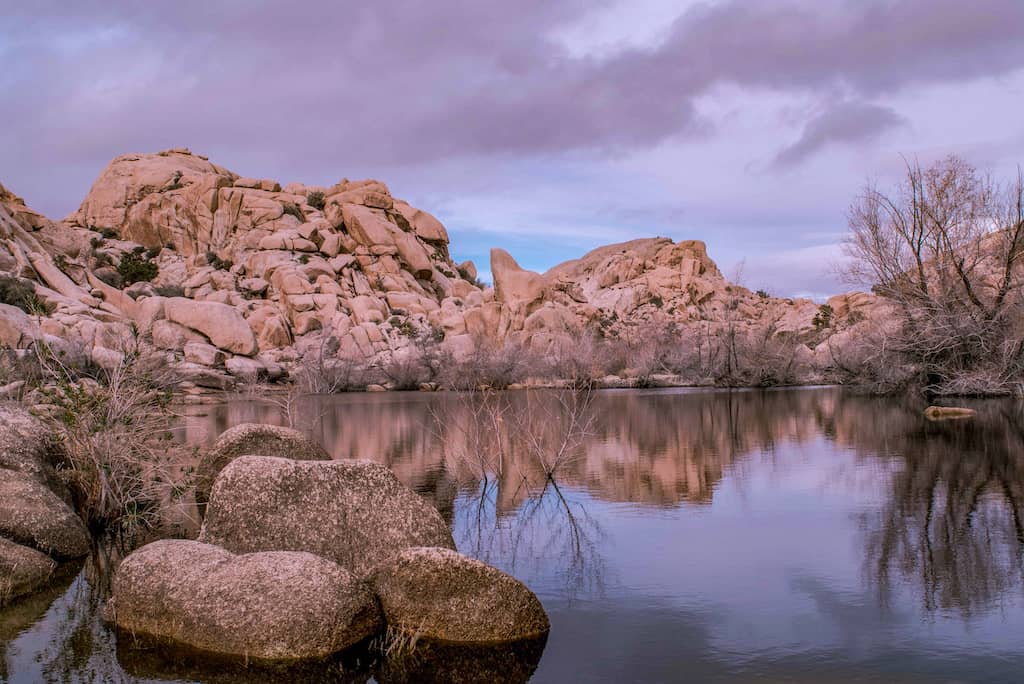
Barker Dam Loop – 1.5-mile loop: This is another favorite! It travels through the southern edge of the Wonderland of Rocks, weaves through narrow rock corridors, past a seasonal lake, and into a beautiful valley surrounded by boulders.
Because this is one of the few places where you’ll find water in Joshua Tree, there’s also a good chance that you’ll see some wildlife. Bighorn sheep are common, as are ravens and songbirds. A short spur trail leads to some petroglyphs on the rocks. Unfortunately, the petroglyphs were painted over with bright colors by a film crew back many years ago.
Hidden Valley Nature Trail – 1-mile loop: Explore an enclosed valley lined with huge boulders in an easy hike suitable for the smallest kids.
Hidden Valley is ground zero for the hundreds of climbers who visit the park each day in the cooler months. Be sure to venture into the verdant canyon, which is just off the trail. Cattle rustlers used to hide their cattle in the canyon, which is covered with dense foliage amid the towering cliffs.
Wall Street Mill Trail – 3 miles (out and back): Saving the best for last, this was our favorite hike (more like a walk) in Joshua Tree National Park. The trail contains all kinds of relics from the defunct Wonderland Ranch, making it a must-visit spot for photographers.
Once upon a time, the Wall Street Mill was the fastest and most modern gold stamp mill in the area. It has been fabulously preserved. Explore the area, and you’ll discover a few old cars and crumbling buildings. Kids love exploring here, and the Joshua trees along the trail are incredible.
Where to Watch the Sunrise and Sunset in Joshua Tree National Park
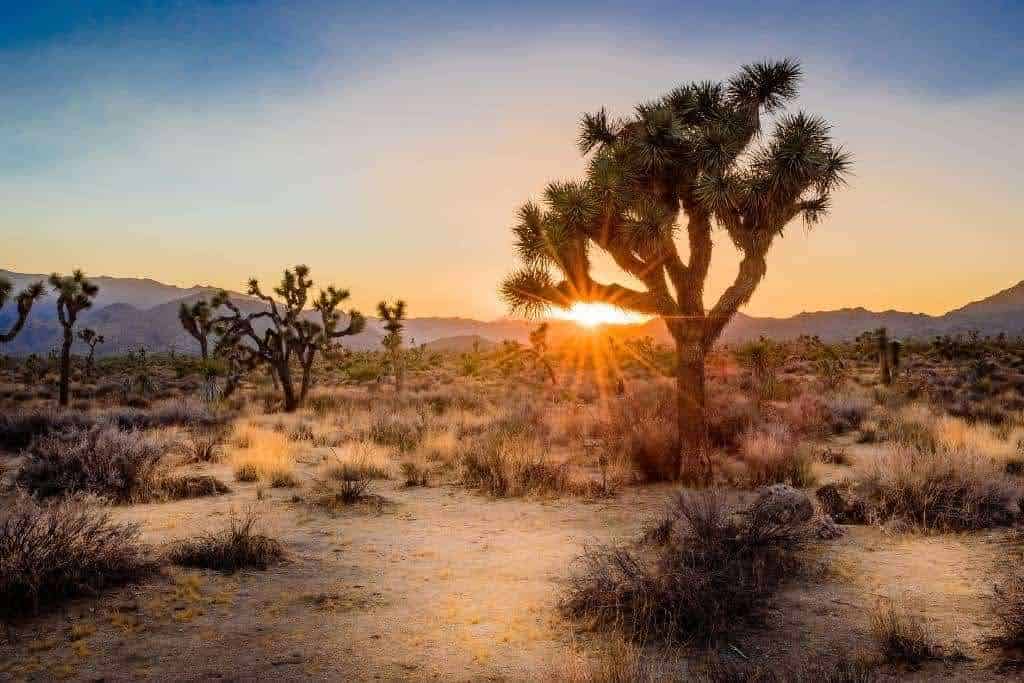
In all honesty, wherever you are in the park, you’ll probably see a fantastic sunrise or sunset, but these are my favorite spots, especially for photography.
- Jumbo Rocks Campground – Those huge rock formations are good for more than a windscreen. Make your best camp coffee, and scramble up the boulders just before sunrise for incredible morning views. I particularly like the area around the amphitheater for photography.
- Key’s View – We stayed at a little motel just outside the park one night, and the owner insisted that we had to watch the sunset from Keys View. You can see for hundreds of miles if there’s no haze from pollution, and the view is truly stunning. It was cloudy when we explored the area, but this is the spot for sunsetting. No hiking is required here. There’s even a wheelchair-accessible viewing platform.
- Barker Dam – Because this is one of the only spots in the park with water, it’s a great place to catch the sun’s reflections as it sinks behind the boulders. If you catch the sunset at the lake, you should have plenty of time to return to your car before dark.
Photographer’s note: There are endless opportunities for photographing Joshua trees within the park. Some of the most exciting photo ops in Joshua Tree present themselves at night when the park comes alive, and the sky provides a spooky backdrop for the gnarly trees.
A Few Extra Adventures for Families in Joshua Tree National Park

Here are some fun adventures in Joshua Tree worth checking out if you have time!
- Family Rock Climbing Lesson: This four-hour guided lesson includes all the equipment you need, plus professionally certified rock climbing guides and wilderness first responders who can work with all types of family groups, no matter your level of experience.
Experience will focus on 1-2 rock formations so that you can spend the bulk of your trip climbing as many routes as possible! - Guided Hiking Tour Customized to Your Group: Explore the otherworldly landscape of Joshua Tree National Park with a customized, guided hiking tour that takes in the best of the region. Tailor the trip to your interests and abilities, and walk to soaring granite formations with sweeping views of the arid terrain. Learn about the plants and animals that thrive in this unique ecosystem, then see Joshua Tree’s fascinating geological history laid bare in the rock record.
- Keys Ranch Tour: To explore Keys Ranch, you must take a ranger-led tour. You can reserve your place on the tour online at Recreation.gov. Keys Ranch has been expertly preserved, and the ranger who gives the tour is funny and engaging. The only caveat is that it’s 1.5 hours of walking and talking, which might be hard for some kids. I’d say it’s good for 10+. If they love history, maybe a bit younger.
Read more about the Keys Ranch Tour in Joshua Tree National Park
Tips for Exploring Joshua Tree with Kids
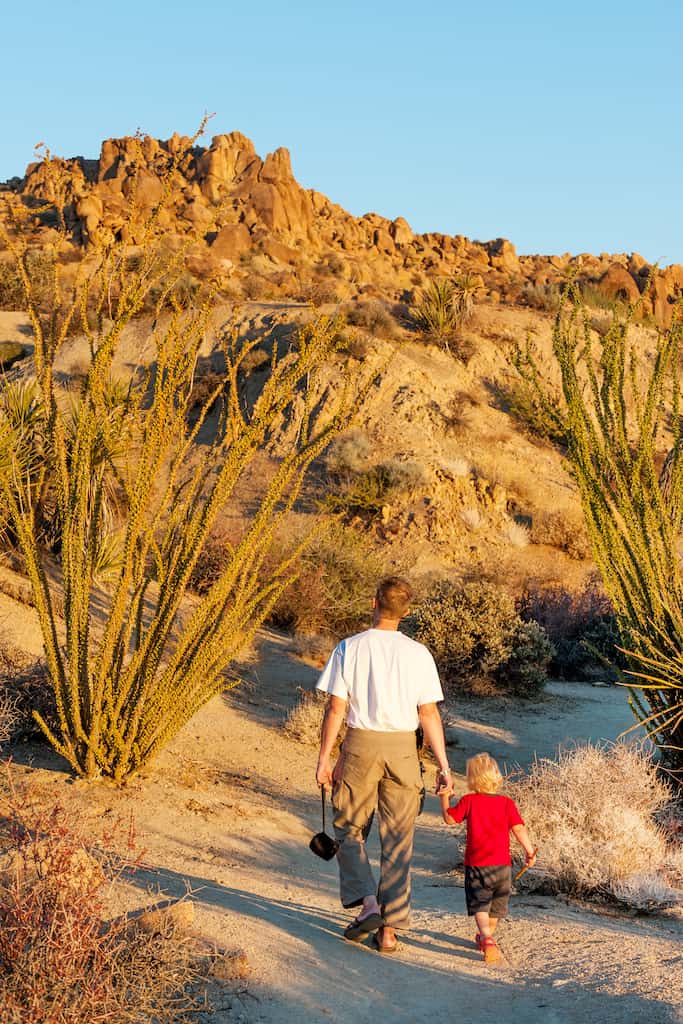
Joshua Tree National Park is a remote park without reliable cell service, so it’s essential to be prepared when adventuring inside the park, whether hiking a remote trail or taking a self-guided driving tour. Channel your inner scout and be prepared by packing the 10 essentials (as a minimum).
Exploring the desert with kids can be a lot of fun, but there are a few risks that parents should be aware of. Follow these hiking tips for safe, fun, and age-appropriate hiking, and be sure to be mindful of these desert-specific dangers —
- Cactus, Joshua Trees, and Yucca Plants: In the desert, children should be taught not to touch the plants they come across. Many of them have been designed to protect themselves with spines, thorns, and prickers.
Did you know that the Joshua tree is also called the desert dagger? That’s because those leaves can cause serious damage. Many yucca plants grow right at eye level for youngsters, making them even more dangerous if kids walk into them. - Poisonous Snakes: Rattlesnakes, scorpions, and black widow spiders are active in the park. On warm days, you can find snakes sunning themselves across roads and trails. Remind your children not to reach into rock crevices where these critters may hide.
Visiting Joshua Tree in the winter months (late November through late February) will minimize your chances of running into these critters. - Dehydration and Sunburn: This is perhaps the most significant threat in Joshua Tree National Park. There is very little water available at the park, so it’s essential to be prepared. A gallon of water per day per person is recommended for adults — half that for kids.
Be sure to encourage your children to drink up, even if they’re not thirsty. Sunglasses, hats with brims, and high-SPF sunblock is recommended, even in the winter. - Mine Shafts: There are still open mine shafts in Joshua Tree National Park. These should never be entered!
- Make a plan for extreme weather: This is a land of extremes, and depending on the time of year you visit, you are likely to experience debilitating heat, windy days with blowing sand, and below-freezing temperatures at night. Summer heat is absolutely brutal, making it hard to explore in the middle of the day.
Joshua Tree FAQs

When is the Best Time to Visit Joshua Tree National Park?
Every season in Joshua Tree is special, but visiting with kids between late October and early April is best to avoid the dangers of sunstroke and extreme heat.
Winter temps can dip below freezing at times, so if you do visit between December and February, bring warm clothes and camp in the southern part of the park (Cottonwood Springs). If you want to experience the desert in bloom, visit Joshua Tree between late February and April.
How do I Get to Joshua Tree National Park?
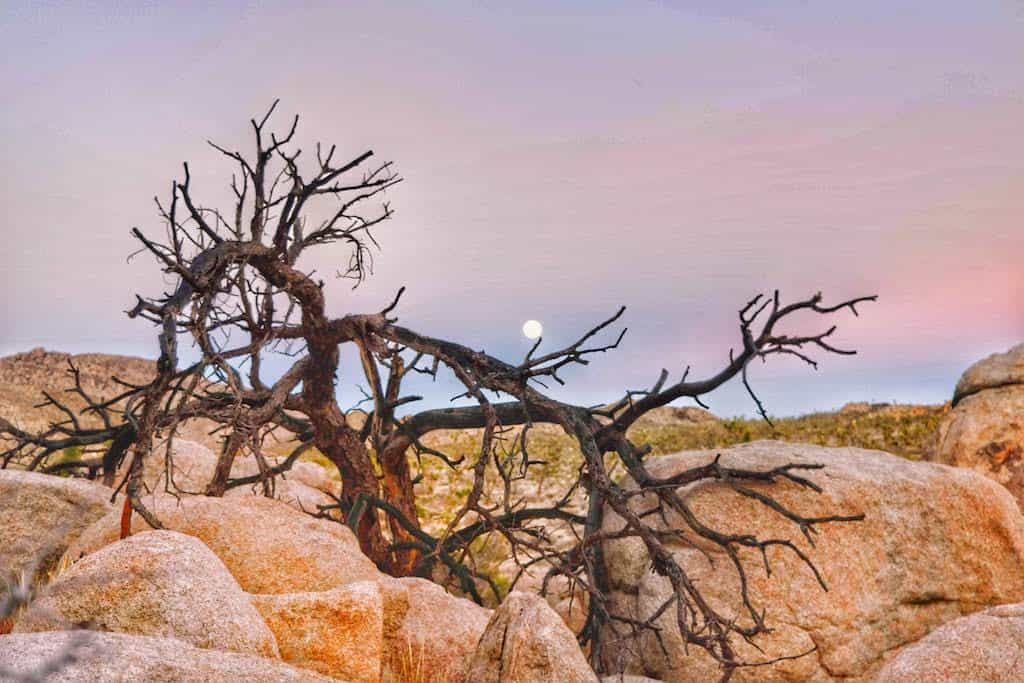
Joshua Tree National Park is about 3.5 hours from LAX in Los Angeles and 3 hours from Las Vegas, but the drive from Las Vegas to Joshua Tree is much easier with less traffic. As we fly from the East Coast, we also find that flying into Vegas is significantly cheaper. Look for deals on Kayak for both flights and car rentals when you start making your plans.
If you drive to Joshua Tree from Las Vegas, it’s pretty much a straight shot south through an empty, mountainous desert to the Twentynine Palms entrance into the park.
Follow us on social – we’d love to keep in touch!


Tara Schatz is a freelance writer and travel blogger with a passion for outdoor adventures. She is the co-author of AMC’s Best Day Hikes in Vermont and currently blogs at Back Road Ramblers and Vermont Explored, where she shares travel tips, adventure destinations, and vacation ideas for the wanderer in everyone.

